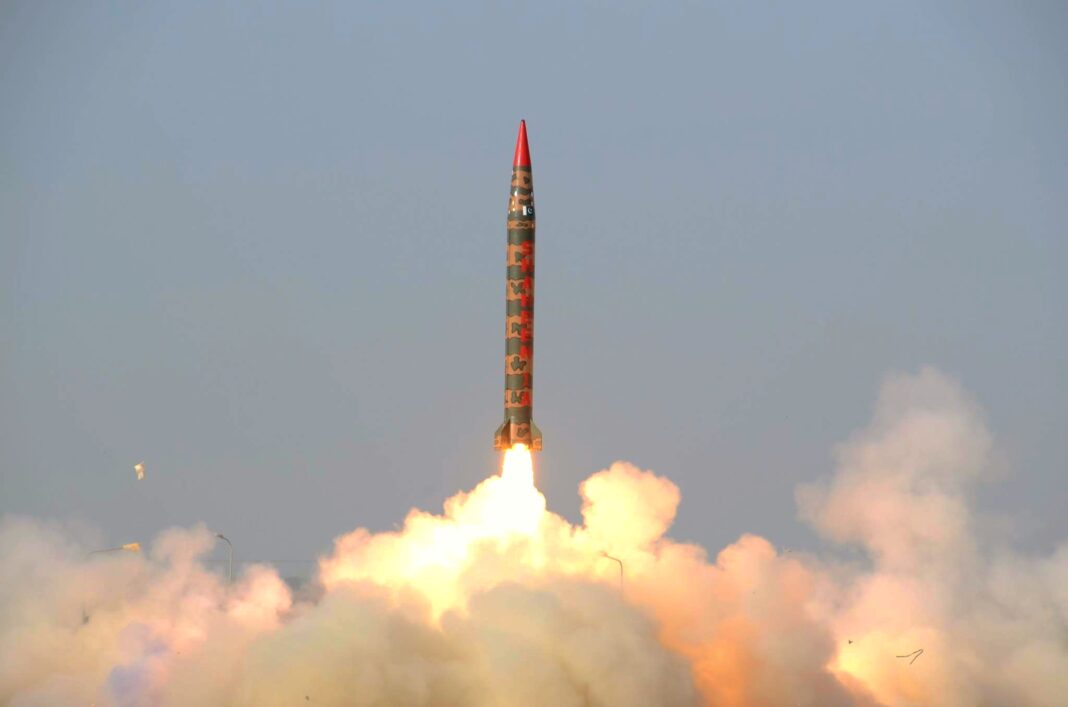By: Kazim Ali
Pakistan’s nuclear program boasts a multifaceted and significant history that has been punctuated by pivotal instances and developments, which collectively have charted its trajectory toward attaining nuclear armament. Initially, Pakistan’s nuclear endeavours were characterized by their modest scope, predominantly geared towards research and scholarly pursuits. The secession of East Pakistan, however, marked a turning point that galvanized Pakistan’s resolve to acquire a nuclear deterrent, driven by a compelling need to address perceived vulnerabilities in its security apparatus. This transformative juncture culminated in the Chagai nuclear test, an event of momentous importance that ushered in a pronounced escalation in Pakistan’s nuclear initiative, consequently earning it international recognition as a nuclear-capable state. This momentum was sustained into the early 21st century, as Pakistan diligently engineered an array of delivery systems, notably ballistic missiles, configured to ferry nuclear warheads, thereby fortifying its capacity for retaliatory action.
Central to Pakistan’s nuclear posture is the doctrine of “Full Spectrum Deterrence,” which underscores the imperative of crafting a robust and credible response to diverse forms of aggression. Throughout its historical trajectory, Pakistan’s nuclear program has been decisively influenced by a complex interplay of security imperatives, regional dynamics, and the overarching pursuit of strategic equilibrium.
Considered to be of immense significance is the composition of Pakistan’s nuclear arsenal, which encompasses both tactical and strategic nuclear armaments. This strategic juxtaposition affords Pakistan a flexible toolkit for effectively addressing an array of threats, with tactical weapons conferring versatility in response, while strategic assets offer an imposing deterrent against more formidable challenges. Notably, this strategic configuration steers Pakistan’s deterrence doctrine away from disproportionate or undue employment of its nuclear arsenal. To this end, Pakistan has meticulously cultivated a diverse array of delivery mechanisms, thereby substantiating the credibility of its deterrence capability. The synergistic interplay of multiple delivery options buttresses Pakistan’s capacity to effectively retaliate in the event of aggression, consequently augmenting the potency and credibility of its deterrence stance.
Pakistan’s nuclear policy pivots around the concept of “Minimum Credible Deterrence” (MCD), a paradigm cantered upon the judicious maintenance of a sufficient, credible, and efficacious nuclear deterrent. This overarching policy objective serves to thwart the advent of aggression while dissuading potential antagonists, chief among them India, from embarking upon military hostilities. Inextricably linked to this policy imperative is the delicate equilibrium between ensuring a robust deterrence and forestalling the spectre of an unwarranted arms race. The No-First Use (NFU) policy, a linchpin of this posture, emerges from a complex tapestry of domestic, regional, and global considerations. This bedrock principle underscores Pakistan’s steadfast commitment to stability, as underscored by its general reluctance to inaugurate nuclear hostilities.
Concomitant with its pursuit of nuclear stability, Pakistan’s nuclear prowess has indelibly etched its mark upon the security dynamics of the region, particularly within the South Asian context. The presence of nuclear arsenals has engendered both stability and intricacies, exerting a palpable influence on strategic interactions and diplomatic endeavours. This arsenal-induced deterrence has functioned as a bulwark against large-scale conventional conflicts between India and Pakistan, instilling circumspection in the handling of disputes and conflicts. The Specter of nuclear reprisal has engendered a tempered approach from both nations, cultivating a climate conducive to diplomatic and political resolutions to conflicts. Illustrated by the Pulwama incident of February 14, 2019, the influence of nuclear deterrence has engendered diplomatic initiatives and confidence-building measures between India and Pakistan, emblematic of the broader pursuit of regional tranquillity.
Pakistan’s engagement with international arms control frameworks, notably the Non-Proliferation Treaty (NPT) and the Comprehensive Nuclear-Test-Ban Treaty (CTBT), represents a dynamic facet of its evolving nuclear deterrence policy. While Pakistan refrains from formal adherence to the NPT due to concerns over its perceived bias, it actively participates in NPT review conferences, aligning with decisions pertaining to nuclear disarmament and non-proliferation, thus signalling its commitment to a world free of nuclear weapons. Although the CTBT remains unratified, Pakistan’s stance is rooted in its regional security calculus.
The exigencies of border tensions and historical events have interfaced with Pakistan’s deterrence policy, contributing to an evolving landscape of regional security and stability. While instances such as the Kargil conflict (1999) and subsequent border skirmishes underscored the potential for escalation, international interventions and diplomacy have played a pivotal role in averting crises and facilitating dialogue. Employing avenues like track II diplomacy, involving academics and civil society representatives, has created forums for discourse, engendering mutual comprehension and conflict resolution. Although full resolution remains elusive, these initiatives have collectively contributed to de-escalation and the preservation of open lines of communication, crucial for forestalling nuclear brinksmanship.
The trajectory of Pakistan’s nuclear deterrence is intertwined with technological advancements, regional dynamics, security imperatives, and international pressures. Future pursuits are poised to encompass technological enhancements across delivery systems, command and control structures, and safety protocols, potentially influencing the precision, range, and credibility of its nuclear arsenal. Pakistan’s thrust toward a credible second-strike capability, possibly through investments in submarine-launched ballistic missiles (SLBMs), reflects a meticulous calibration of deterrence strategies, while remaining acutely sensitive to political ramifications. The evolving geopolitical context in South Asia may further influence the contours of deterrence and defence doctrines.
In summation, Pakistan’s nuclear policy is a product of intricate interactions between technological progress, regional dynamics, security considerations, and international engagements. Navigating this complex terrain necessitates a proactive approach that balances national security imperatives with responsible nuclear stewardship, thereby mitigating risks and upholding regional stability.
The writer is a student of defence and strategic studies at Quaid i Azam University, Islamabad. He can be reached at [email protected]






